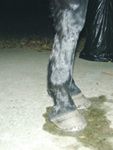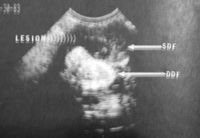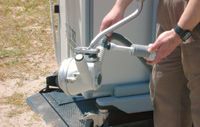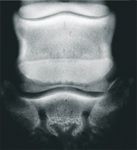Evaluating treatment choices for tendon, ligament injury and joint disease in the horse
In the first of these articles we looked at the wide array of different treatment modalities and therapies available for use in horses suffering from varying types of tendon and ligament injuries, and forms of joint disease. Multiple treatment options are available, from stem cells to platelet-rich plasma to shock-wave therapy to Tildren.
In the first of these articles we looked at the wide array of different treatment modalities and therapies available for use in horses suffering from varying types of tendon and ligament injuries, and forms of joint disease. Multiple treatment options are available, from stem cells to platelet-rich plasma to shock-wave therapy to Tildren.

Photo 1: Horses with trauma to the splint bones often have reactive thickened bones that may not be fractured or damaged structurally. These thickened metacarpal or metatarsal bones may cause irritation and possible trauma to associated tendons and ligaments, however, and produce a problem for the performance horse. Extracorporeal shock-wave therapy (ESWT) has been shown to be effective in these cases. (PHOTOS: DR. KENNETH L. MARCELLA.)
This multitude of choices has produced some confusion, and many equine veterinarians have been looking for some research or clinical evidence that will help clarify the issue.
But there is a lack of comparative studies with head-to-head testing, making correct and efficacious choices from among the many options difficult. Similar cases referred to different veterinary schools or to different clinical centers often are treated with differing modalities, furthering the confusion. Published research tends to evaluate an individual therapy itself without comparison or contrast to other methods of healing.
Dr. Rodger Smith of the Department of Veterinary Clinical Sciences at the Royal Veterinary College, University of London, makes this point in an article in the British Journal of Sports Medicine.
In his article on harnessing stem cells for the treatment of tendon and ligament injuries, Smith states, "a multitude of treatments have been advocated for the management of tendon over-strain injuries, but there is little evidence in any species that any is more effective than a prolonged period of rehabilitation with carefully controlled exercise."

Photo 2a: Damage to tendons and ligaments is common in equine athletes. Newer treatment options include platelet-rich plasma, bone marrow- or fat-derived stem cells and A-cell tissue. Clinical experience, treatment familiarity and bias are still the most common reasons for specific choices and recommendations by veterinarians.
Studies comparing different treatment options for tendon injuries with good rest/rehabilitation programs are not available, and it is questionable if they will even be done.
There is little commercial benefit in proving that "rest works best," and the practical issues of doing tendon injury and healing studies may make such clinical trials realistically impossible.
"Equine superficial digital flexor tendon injuries (and generally all equine tendon and ligament damages) are highly variable, and controlled studies are almost impossible to perform in an environment in which treatment is essentially private and dominated by owner/trainer preference," Smith explains.

Photo 2b: This ultrasound shows a core lesion to the deep digital flexor tendon (DDF) and superficial digital flexor tendon (SDF). These types of injuries are well suited to stem-cell injection and stem-cell use. This, along with injection of platelet-rich plasma, seems to provide the best healing.
Clients have heard the claims of faster, stronger healing with various treatments, so getting "control" horses in a study that do not receive these treatments or comparative horses treated conservatively is very difficult.
Without comparative research to guide the decision-making process for the average practitioner, it may be beneficial to look at current treatments used for various cases and problems from the standpoint of clinicians, researchers and practitioners who are more familiar with these therapy options and have found some "comfort zone" through their application to numerous cases.
While this cannot be an exhaustive review and there certainly is room for other opinions, this is the current state of knowledge for use of these treatments in the athletic horse.
ESWT
"I am still very pleased with the results I am getting with shock-wave treatment (extracorporeal shock-wave therapy, or ESWT)," says Dr. Hugh Warsham of Foxdale Equine in Georgia. "I treat mostly hunter/jumper injuries, and case selection is very important to success, but for suspensory ligament desmitis shock-wave has been great."

Photo 3: The use of ultrasound-guided, shock-wave equipment (as shown here) has greatly improved both the delivery and the success of this treatment in the horse.
Most practitioners agree that ESWT works best for injuries located proximally in the suspensory and that forelimb injuries respond better than hind-limb problems.
Shock-wave therapy has been receiving attention for its effects on problems of the equine spine as well.
"I have been treating back stiffness, largely from issues related to the spinous processes and have found that horses respond well, though I cannot be sure if they are responding to actual osseous remodeling and repair or to the well-documented analgesic effect noted with ESWT," says Warsham.
This modality is still believed to be the best option for non-healing fractures and problems of the splint bones.

Photo 4: Bone remodeling along the edges of the navicular bone contributes to the pain and lameness seen in this condition. Tildren functions by slowing bone destruction and new osteophyte production, and is believed to help lessen the inflammation, cellular destruction and pain in these cases.
"ESWT has worked well for me in cases of reactive splint bones, especially with axial suspensory ligament involvement," says Warsham.
Platelet-rich plasma
Platelet-rich plasma, on the other hand, is favored by a number of clinicians for the treatment of many ligament and tendon conditions and for use in cases of proximal suspensory desmitis rather than ESWT. Dr. Andris Kaneps of the New England Equine Medical and Surgical Center states, "In our hands, PRP alone has been effective in resolving 75 percent to 80 percent of high- to mid-body suspensory desmitis cases.
"I have used PRP for any significant tendon or ligament injury I have encountered."
PRP does provide a substantial increase of non-specific, local-tissue growth factors, and Kaneps explains that these factors last much longer than one might expect — several months in some laboratory animal studies.
"The advantages of PRP are," according to him, "relatively low cost, autologous, easy to do on an outpatient basis and excellent results for most soft-tissue injuries."
Many clinics are combining PRP and stem cells for tendon and ligament injuries.
This "best of both worlds" treatment seems to have a synergistic effect in some types of injuries. Kaneps uses fat-derived stem cells for their anti-inflammatory properties and for the promotion of tissue-growth factors.
"I have used a combination of fat-derived stem cells and PRP for the injection of suspensory-branch injuries because we have success only in slightly fewer than half of the horses with this injury that we inject with PRP alone," Kaneps says. The PRP/stem-cell combination is considered by him, Warsham and others to improve that treatment success rate substantially.
Stem cells
Many clinicians are using either fat-derived or bone marrow-derived stem cells for the treatment of many types of tendon and ligament injuries, and some use stem cells for joint therapy as well. The benefits are similar to those for PRP, and many performance clients have embraced this therapy because, with the cells coming from the same horse, there is no withdrawal time and horses can have their joints injected almost right up to the start of competition.
Statistics for stem-cell treatment of tendon and ligament injuries generally are good, with most studies reporting about a 70 percent return to function for these horses. Dr. Ted Vlahos of Sheridan, Wyo., urges caution with stem-cell tendon and ligament repair, however. "We have been very happy with the use of fat-derived stem cells for soft-tissue repair," says Vlahos. "We have noted that this treatment will produce outstanding healing, and a horse's ultrasound scan will look remarkable at two months post-treatment. These roping and cutting horses in our practice will not have fully functional tendons and ligaments at that point, so additional healing and rehabilitation time must be allowed," he advises.
An early return to work for these athletes, based on a normal ultrasound scan as was the previously used procedure, can mean re-injury and additional lost performance time.
IRAP
The use of interleukin receptor antagonist protein (IRAP) is increasing, with most clinicians reporting that it is primarily used for those cases of joint arthritis that are chronic and generally non-responsive to standard intra-articular injections.
Equine athletes suffering from chronic joint over-use injury and that have a synovitis or sub-chondral aspect to their joint pain seem to respond well to IRAP, according to various clinicians, though others question the length of action of this therapy. The ease of production of IRAP injections and their autologous nature are proving to be big factors in the acceptance and use of this treatment modality.
Tildren
Tildren acts chiefly through the mechanism of bone production and resorbtion, so conditions such as osseous cyst lesions, navicular bone degeneration and ligament/bone attachment injuries (collaterals, deep digital flexor tendon-coffin bone, cruciate ligaments) are all cases where there should be significant effect.
"In our practice," says Kaneps, "Tildren has been very effective in cases with lameness associated with aggressive bone modeling." Because Tildren has been used in Europe for some time, U.S. veterinarians who now have experience using it have developed a new perspective on past cases.
"A while or so back we would receive mature performance horses with long careers imported from Europe with reasonable radiographs and no lameness issues when they arrived," explains Warsham. "Then, for no reason, after a while, they would develop any number of lameness issues. We started thinking that they (European owners, trainers and veterinarians) must have had something, probably Tildren, that they were using to help keep these 'older soldiers' sound," Warsham concludes.
Tildren does seem to work well in helping reduce osteophyte production and bone remodeling. Many practitioners are finding a reduction in arthritic pain with its use.
Summary
A closer look at the therapies and treatments available for use in the horse for tendon, ligament and joint repair, through the eyes of some of those clinicians utilizing these modalities, does produce some good recommendations and practical guidelines.
Practitioner bias based on familiarity and history is still prevalent, though. The absence of head-to-head studies likely will mean that these regional or personal preferences will continue to affect treatment choices and recommendations.
"The idea of regenerative medicine (stem cells, PRP, IRAP and other treatments) is exciting and holds great promise", adds Dr. Mike Scott of Alberta, Canada, in remarks at the 2009 Canadian Horse Breeders and Owners Conference. "This novelty and excitement has led to the rapid establishment of treatment techniques and commercial products. Veterinarians and horse owners should be aware of these developments and consider these treatments when the need arises," Scott said, "but they should use caution when accepting unrealistic claims and should investigate the facts before expecting miracles."
Hopefully more cases, better follow-up and some comparative studies in the near future will provide veterinarians and owners with more "facts" to investigate in order to make better treatment choices.
Marcella is an equine practitioner in Canton, Ga.
Podcast CE: A Surgeon’s Perspective on Current Trends for the Management of Osteoarthritis, Part 1
May 17th 2024David L. Dycus, DVM, MS, CCRP, DACVS joins Adam Christman, DVM, MBA, to discuss a proactive approach to the diagnosis of osteoarthritis and the best tools for general practice.
Listen